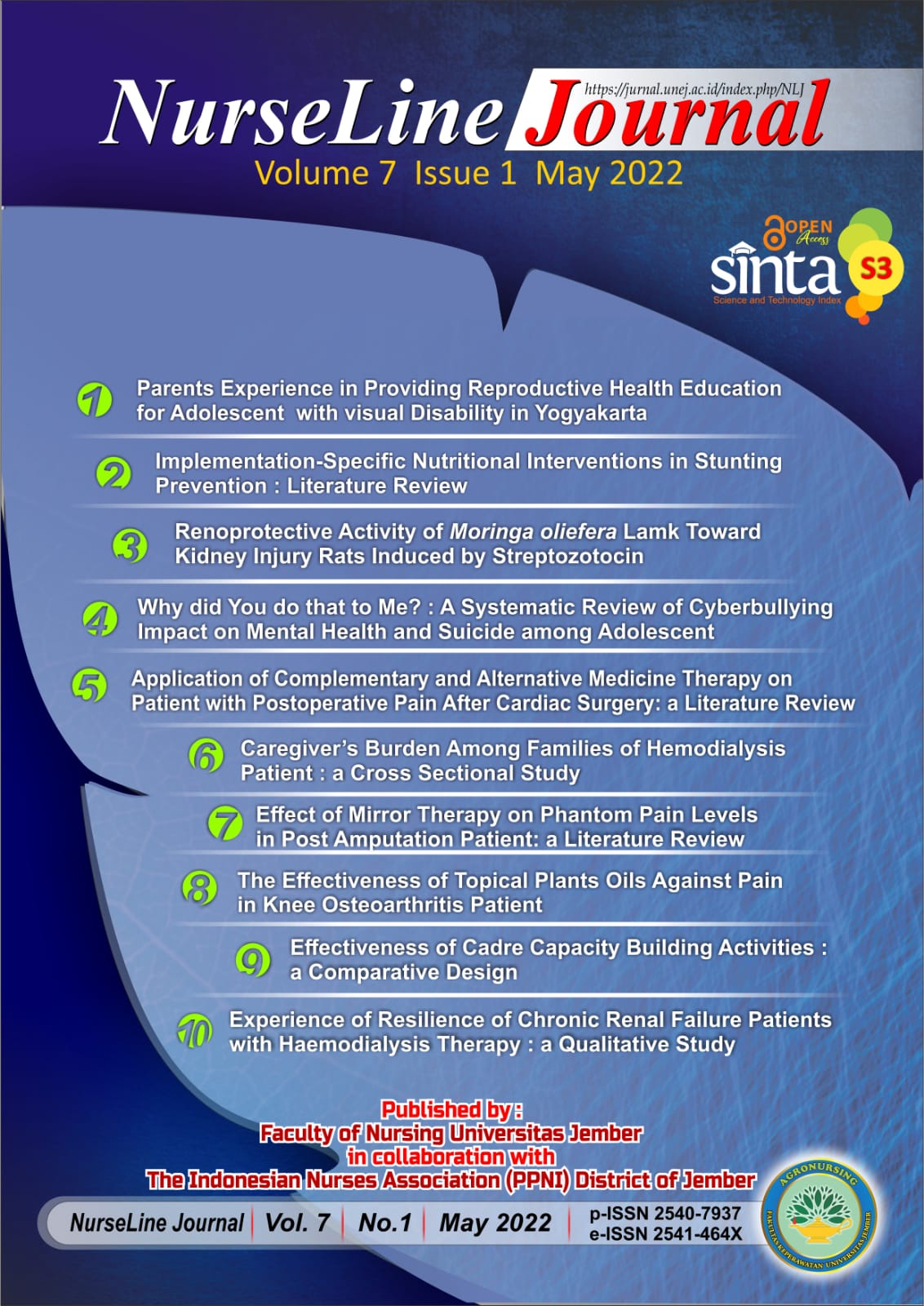Why did You do that to Me?: a Systematic Review of Cyberbullying Impact on Mental Health and Suicide Among Adolescents
DOI:
https://doi.org/10.19184/nlj.v7i1.27311Keywords:
adolescents, cyberbullying, mental healthAbstract
With the new implementation of distance learning, adolescents have more time to access the internet. Lack of surveillance from parental figures and developing senses of mental stability make adolescents susceptible to the negative influence of the internet such as cyberbullying. This systematic literature review aims to examine the incidence of cyberbullying and its effect on the risk of mental health disorders and suicide among adolescents during the COVID-19 pandemic. A total of 10 cross-sectional studies were sorted out from major electronic journal databases: PubMed, Science Direct, BMC, Sage Journal, and Google Scholar using the following search term combinations: “adolescents†“cyberbullying†“suicide†“depressionâ€. The range for adolescents age was 11-18 years. These studies identified and examined general internet use, the experience of cyberbullying, effects on mental health disorder, and risk of suicide published from January 2020 to July 2021. Cyber victimization was positively associated with stress, suicidal ideation, and avoidance which is also a significant predictor of self-harm. Adolescents who experienced cyberbullying were 2-3.14 times more likely to report experiencing suicidal ideations. Suicidal attempts were significantly 2.14 times higher on adolescents who have cyberbullying experience. Previously victimized adolescents have a 15.5% higher chance of being cyberbullied. Internet usage and addiction have direct effects on mediating cyber victimization and adolescents’ psychological symptoms. This study has given broader insight into how cyberbullying can affect mental health in adolescents and identify the gaps for further longitudinal research on cyberbullying among adolescents.
Downloads
References
Albdour, M., L. Lewin, K. Kavanaugh, J. S. Hong, dan F. Wilson. 2016. Arab american adolescents’ perceived stress and bullying experiences: a qualitative study: Https://Doi.Org/10.1177/0193945916678214. 39(12):1567–1588.
Baiden, P. dan S. K. Tadeo. 2020. Investigating the association between bullying victimization and suicidal ideation among adolescents: evidence from the 2017 youth risk behavior survey. Child Abuse and Neglect. 102(May 2019):104417.
Baiden, P., S. K. Tadeo, B. C. Tonui, J. D. Seastrunk, dan G. O. Boateng. 2020. Association between insufficient sleep and suicidal ideation among adolescents. Psychiatry Research. 287:112579.
Barcaccia, B., B. Howard Schneider, S. Pallini, dan R. Baiocco. 2017. Bullying and the detrimental role of un-forgiveness in adolescents’ wellbeing. Psicothema. 29(2):217–222.
Bottino, S., C. Bottino, C. Regina, A. Correia, dan W. Ribeiro. 2015. Cyberbullying and adolescent mental health: systematic review. Cadernos de Saude Publica. 31(3):463–475.
Chaux, E. dan M. Castellanos. 2015. Money and age in schools: bullying and power imbalances. Aggressive Behavior. 41(3):280–293.
Chu, X. W., C. Y. Fan, Q. Q. Liu, dan Z. K. Zhou. 2018. Cyberbullying victimization and symptoms of depression and anxiety among chinese adolescents: examining hopelessness as a mediator and self-compassion as a moderator. Computers in Human Behavior. 86:377–386.
Farahani, H. A., S. Aghamohamadi, Z. Kazemi, F. Bakhtiarvand, dan M. Ansari. 2011. Examining the relationship between sensitivity to rejection and using facebook in university students. Procedia - Social and Behavioral Sciences. 28:807–810.
Fitransyah, R. 2018. Perilaku cyberbullying dengan media instagram pada remaja di yogyakarta. Indonesian Journal of Nursing Practice. 2(1):36–48.
Ford, C. A., J. H. Mirman, J. F. GarcÃa-España, M. C. F. Thiel, E. Friedrich, E. C. Salek, dan J. Jaccard. 2019. Effect of primary care parent-targeted interventions on parent-adolescent communication about sexual behavior and alcohol use: a randomized clinical trial. JAMA Network Open. 2(8):e199535–e199535.
Fredrickson, B. 2001. The role of positive emotions in positive psychology. the broaden-and-build theory of positive emotions. The American Psychologist. 56(3):218–226.
Hinduja, S. dan J. W. Patchin. 2017. Cultivating youth resilience to prevent bullying and cyberbullying victimization. Child Abuse & Neglect. 73:51–62.
Hunter, S. dan J. Boyle. 2004. Appraisal and coping strategy use in victims of school bullying. The British Journal of Educational Psychology. 74(Pt 1):83–107.
Islam, M. I., R. Khanam, dan E. Kabir. 2020. Bullying victimization, mental disorders, suicidality and self-harm among australian high schoolchildren: evidence from nationwide data. Psychiatry Research. 292(August):113364.
Kim, J. H., E. Walsh, K. Pike, dan E. A. Thompson. 2020. Cyberbullying and victimization and youth suicide risk: the buffering effects of school connectedness. Journal of School Nursing. 36(4):251–257.
Kominfo. 2020. Terjadi Pergeseran Penggunaan Internet Selama Masa Pandemi. https://kominfo.go.id/content/detail/26060/terjadi-pergeseran-penggunaan-internet-selama-masa-pandemi/0/berita_satker [Diakses pada August 17, 2021].
Kowalski, R. dan S. Limber. 2013. Psychological, physical, and academic correlates of cyberbullying and traditional bullying. The Journal of Adolescent Health : Official Publication of the Society for Adolescent Medicine. 53(1 Suppl)
Lin, L., J. Liu, X. Cao, S. Wen, J. Xu, Z. Xue, dan J. Lu. 2020. Internet addiction mediates the association between cyber victimization and psychological and physical symptoms:moderation by physical exercise. BMC Psychiatry. 20(1):1–8.
Liu, Q., Y. Lin, Z. Zhou, dan W. Zhang. 2019. Perceived parent–adolescent communication and pathological internet use among chinese adolescents: a moderated mediation model. Journal of Child and Family Studies 2019 28:6. 28(6):1571–1580.
MartÃnez-Monteagudo, M., B. Delgado, C. Inglés, dan R. Escortell. 2020. Cyberbullying and social anxiety: a latent class analysis among spanish adolescents. International Journal of Environmental Research and Public Health. 17(2)
Nagamitsu, S., M. Mimaki, K. Koyanagi, N. Tokita, Y. Kobayashi, R. Hattori, R. Ishii, M. Matsuoka, Y. Yamashita, Z. Yamagata, T. Igarashi, dan P. E. Croarkin. 2020. Prevalence and associated factors of suicidality in japanese adolescents: results from a population-based questionnaire survey. BMC Pediatrics. 20(1):1–9.
Nguyen, H. T. L., K. Nakamura, K. Seino, dan V. T. Vo. 2020. Relationships among cyberbullying, parental attitudes, self-harm and suicidal behavior among adolescents: results from a school-based survey in vietnam. BMC Public Health. 20(1):1–9.
Nugaraha, E. 2019. Merunut Lemahnya Hukum Cyberbullying Di Indonesia. https://www.aminef.or.id/merunut_lemahnya_hukum_cyberbullying_di_indonesia/ [Diakses pada August 16, 2021].
Nurhayati-Wolff, H. 2021. Indonesia: Daily Time Spent Using Online Media by Activity 2020. https://www.statista.com/statistics/803524/daily-time-spent-using-online-media-by-activity-indonesia/ [Diakses pada August 17, 2021].
Ogurlu, U. dan H. Sarıçam. 2018. Bullying, forgiveness and submissive behaviors in gifted students. Journal of Child and Family Studies 2018 27:9. 27(9):2833–2843.
Ortega, R., P. Elipe, J. Mora-Merchán, M. Genta, A. Brighi, A. Guarini, S. PK, F. Thompson, dan N. Tippett. 2012. The emotional impact of bullying and cyberbullying on victims: a european cross-national study. Aggressive Behavior. 38(5):342–356.
Özdemir, Y. 2014. Cyber victimization and adolescent self-esteem: the role of communication with parents. Asian Journal of Social Psychology. 17(4):255–263.
Peled, Y. 2019. Cyberbullying and its influence on academic, social, and emotional development of undergraduate students. Heliyon. 5(3):e01393.
Quintana-Orts, C., L. Rey, dan J. Everett L. Worthington. 2019. The relationship between forgiveness, bullying, and cyberbullying in adolescence: a systematic review: Https://Doi.Org/10.1177/1524838019869098. 22(3):588–604.
Quintana-Orts, C., L. Rey, dan F. Neto. 2020. Beyond cyberbullying: investigating when and how cybervictimization predicts suicidal ideation. Journal of Interpersonal Violence
Raskauskas, J. dan A. Huynh. 2015. The process of coping with cyberbullying: a systematic review. Aggression and Violent Behavior. 23:118–125.
Reed, K. P., R. L. Cooper, W. R. Nugent, dan K. Russell. 2016. Cyberbullying: a literature review of its relationship to adolescent depression and current intervention strategies. Https://Doi.Org/10.1080/10911359.2015.1059165. 26(1):37–45.
Rey, L., C. Quintana-Orts, S. Mérida-López, dan N. Extremera. 2020. The relationship between personal resources and depression in a sample of victims of cyberbullying: comparison of groups with and without symptoms of depression. International Journal of Environmental Research and Public Health. 17(24):1–14.
Ronis, S. dan A. Slaunwhite. 2017. Gender and geographic predictors of cyberbullying victimization, perpetration, and coping modalities among youth. Canadian Journal of School Psychology. 1–19.
Strohacker, E., L. E. Wright, dan S. J. Watts. 2021. Gender, bullying victimization, depressive symptoms, and suicidality. International Journal of Offender Therapy and Comparative Criminology
Wang, P., L. Lei, G. Yu, dan B. Li. 2020. Social networking sites addiction and materialism among chinese adolescents: a moderated mediation model involving depression and need to belong. Frontiers in Psychology. 0:3373.
Williams, C. A., J. D. Doorley, dan C. Esposito-Smythers. 2017. Interpersonal rejection sensitivity mediates the associations between peer victimization and two high-risk outcomes: Https://Doi.Org/10.1177/1359104517712041. 22(4):649–663.
Xin, M., P. Chen, Q. Liang, C. Yu, S. Zhen, dan W. Zhang. 2021. Cybervictimization and adolescent internet addiction: a moderated mediation model. International Journal of Environmental Research and Public Health. 18(5):1–13.
Zvolensky, M., C. Jardin, L. Garey, Z. Robles, dan C. Sharp. 2016. Acculturative stress and experiential avoidance: relations to depression, suicide, and anxiety symptoms among minority college students. Cognitive Behaviour Therapy. 45(6):501–517.








